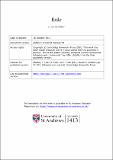Files in this item
Exile
Item metadata
| dc.contributor.author | Stabler, Jane | |
| dc.contributor.editor | Tuite, Clara | |
| dc.date.accessioned | 2022-08-26T10:30:08Z | |
| dc.date.available | 2022-08-26T10:30:08Z | |
| dc.date.issued | 2019-12 | |
| dc.identifier | 251375363 | |
| dc.identifier | dcdde326-a11f-4508-8215-f8d8cdd789f7 | |
| dc.identifier | 000517229300004 | |
| dc.identifier | 85097587901 | |
| dc.identifier.citation | Stabler , J 2019 , Exile . in C Tuite (ed.) , Byron in context . Literature in context , Cambridge University Press , Cambridge , pp. 31-37 . https://doi.org/10.1017/9781316850435.004 | en |
| dc.identifier.isbn | 9781107181465 | |
| dc.identifier.isbn | 9781316632673 | |
| dc.identifier.isbn | 9781316850435 | |
| dc.identifier.uri | https://hdl.handle.net/10023/25896 | |
| dc.description.abstract | Byron rehearsed going into exile in 1809, when he was twenty-one years old. Before setting sail for Lisbon, he wrote, “I leave England without regret, I shall return to it without pleasure. – I am like Adam the first convict sentenced to transportation, but I have no Eve, and have eaten no apple but what was sour as a crab and thus ends my first Chapter” (BLJ 1: 211). Byron’s sardonic perception of himself as a biblical exile foreshadowed the allusive character of his second longer-term exile at the age of twenty-eight, when his carefully staged exit required an audience (some of the same friends and servants), expensive props (a replica of Napoleon’s carriage) and a literary precursor. On his last evening in England, Byron visited the burial place of the satirist Charles Churchill, and lay down on his grave. It was a performance of immense weariness with life and solidarity with an embittered outcast. | |
| dc.format.extent | 259150 | |
| dc.language.iso | eng | |
| dc.publisher | Cambridge University Press | |
| dc.relation.ispartof | Byron in context | en |
| dc.relation.ispartofseries | Literature in context | en |
| dc.subject | PE English | en |
| dc.subject | T-NDAS | en |
| dc.subject.lcc | PE | en |
| dc.title | Exile | en |
| dc.type | Book item | en |
| dc.contributor.institution | University of St Andrews. School of English | en |
| dc.identifier.doi | https://doi.org/10.1017/9781316850435.004 | |
| dc.date.embargoedUntil | 2020-04-04 | |
| dc.identifier.url | https://doi.org/10.1017/9781316850435 | en |
This item appears in the following Collection(s)
Items in the St Andrews Research Repository are protected by copyright, with all rights reserved, unless otherwise indicated.

